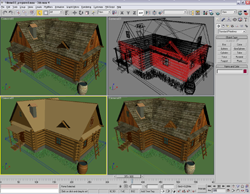Test results. Designer's work modeling.
We have divided our tests into subdivisions. The first test, quite sizeable,
is scarce in description as there is only subjective estimation. Nevertheless,
I will try to describe the process as detailed as possible.
For modeling of real operation we left first three demo scenes. We checked
rotation of objects in a scene and their transition in different planes,
and rotation and transition of the camera. What we estimated is image quality
and simplicity of operation.



After that the work was done separately in each window enlarged to the
full-screen size and in all 4 windows.
I combined description of all cards into one because the difference
in real operation is not very noticeable; the subjective estimations are
similar, and differences will be focused on separately.
The first scene loads almost immediately on all platforms and with different
drivers, the loading time doesn't exceed 1 sec.
In the wireframe mode, in a full window, both under the OpenGL API and
with special drivers (MAXtreme for the Quadro line and MAXIMUM for the
FireGL 8800) the scene works well, no delays, images are redrawn quickly,
both on the Athlon XP and on the Pentium 4 stands.
In the facets mode, in a full window, under the OpenGL API the Quadro2
MXR and Quadro2 PRO cards draw the scenes jerkily when the cameras are
rotating and moving (though not under the MAXTreme). All other cards under
different drivers on different platforms do not work such a way.
The smooth+highlights mode, without textures, showed good and quick
operation under all APIs on all platforms. The smooth+highlights mode with
textures didn't differ.
In 4 windows the 3D MAX works slower under the MAXtreme driver, but
it's convenient to work; under the MAXIMUM it doesn't work so. All windows
are redrawn quickly, the delay is not more than half a second. No rendering
errors were noticed on any accelerator. Note that with the Wildcat II 5000,
Quadro3 DCC, Quadro4 750XGL, Quadro4 900XGL and FireGL 8800 all 4 windows
are redrawn almost synchronously. It's better to work under the MAXIMUM
on the FireGL 8800 in the wireframe mode.
For the second scene it took 2 seconds to load both on the Athlon XP
and on the Pentium 4.
The toughest task was a mode of visualization of 4 windows. They were
redrawn too slowly, during 2-3 seconds on all APIs on all cards. In the
wireframe mode, in a full window, repainting was half a second behind the
mouse both in the OpenGL and in the special drivers, in other modes it
was one third behind. I think that it's more convenient to work with this
scene under the Pentium 4.
For the third scene it took 25 s to load; it was inconvenient to work
with it in all modes, under all platforms on all APIs. In all modes the
mouse was noticeably ahead, images jerked. In the "4-window" mode it took
3-4 s for windows to be redrawn on the Quadro2 MXR, Quadro2 PRO, Quadro
DCC, FireGL2 and FireGL 8800 and 2-3 s on other accelerators.
On the whole, there are 4 cards with which it's better to work: FireGL
8800, Quadro4 750XGL, Quadro4 900XGL and Wildcat II 5000. Besides, the
Intel's platform performs better, maybe because the given 3D MAX version
is optimized for this platform.
Well, that was my own opinion. And now let's take a look at the figures.
Remember that the tests are just half-synthetic.
[ Part
3 ]
Write a comment below. No registration needed!



